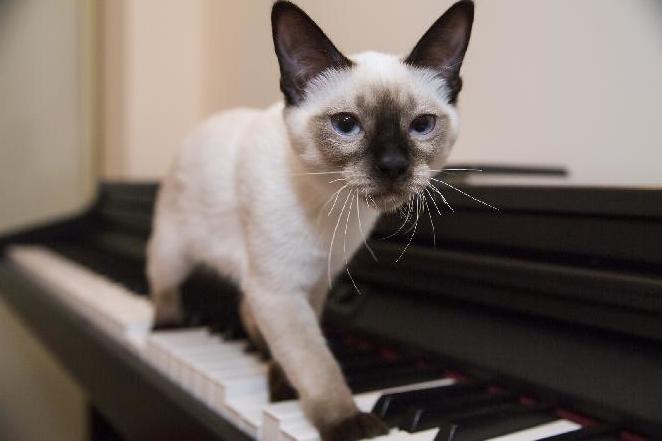
12 minute read
cats react to negative human emotional states
f e l i n e Quick Cat Behavior Tip: Nighttime Wakefulness
The PPG Cat Committee addresses the common issue of felines who keep their guardians awake at night
Advertisement
Cats keeping their sensory deficits to have people awake at variable sleepwake cynight, whether by cles. Many cats begin to zooming around the encounter agerelated house, chasing or playing physical changes bewith a toy, interacting tween 7 and 10 years of with other cats in the age. See your feline home, or “talking”/vocal health practitioner to enizing (usually loudly) will sure your feline family be a familiar concept to member does not have many a cat guardian, who an underlying medical may have suffered a dis issue. turbed night more than The cause(s) for a cat’s There are five main once. Fortunately, there nighttime wakefulness categories of wellness are a number of steps those of us who share our lives with cats can take to try to keep our kitties must be determined and addressed appropriately and effectively testing for senior cats: complete blood count (CBC), biochemistry pro file, urinalysis, thyroid calmer at night and en hormone testing, and sure they remain on a © Can Stock Photo / vetdoctor blood pressure assessmore “humanfriendly” schedule. Cats are crepuscular, meaning they tend to be active at dawn and dusk when the animals they prey upon are most active, an activity pattern that doesn’t always coincide with that of their guardians ment. Comprehensive testing is recommended for senior cats due to the Important Reminders about the Behavior higher risk of underlying disease. These important medical profiles are • Cats are crepuscular, which means they tend to be active at recommended every six months for senior cats. Most cats enter their dawn and dusk when the animals they prey upon (e.g., ro senior years at 8 to 10 years old. dents and birds) are most active. This activity pattern often doesn’t coincide with the cat guardian’s schedule of leaving Management and Safety Information*: the house early, working all day, and returning in the evening • Avoid playing with your cat on your bed. to relax and unwind, and to sleep at night. • Make sure your cat’s litter boxes are clean and well lit (use • The cause(s) for a cat’s nighttime wakefulness must be deter nightlights if necessary). mined and addressed appropriately and effectively. Don’t just • Make sure your cat has access to fresh, clean water before ignore your cat without making an effort to discover what going to bed. Wet food or raw food tends to complete the needs he has that might not be getting met. hunteatgroomsleep cycle much more effectively than dry • Avoid all forms of discipline and punishment, as they can food alone, creating a more content kitty. make your cat fearful of you, can damage the bond you have • Locate water separately from your cat’s food, and keep both with your cat, and can also cause him to direct frustrationre food and water far from litter boxes. lated behaviors toward other animals or people in the home. • Make sure your cat has plenty of cozy and quiet sleeping Also, avoid closing the cat out of the bedroom, or in another places. Consider providing a heated cat bed or selfwarming room or separate area of the home, at night and/or using mat. other deterrents, as they can cause undue stress and lead to • Create a detailed spreadsheet of hourly behavior of both hufurther behavior problems. Such methods also risk breaking mans and cat(s) in the home: down the bond between cats and their people. o Write down a 24hour timeline of what behavior is oc• Underlying medical issues can contribute to disrupted sleep curring when. For example, 6 a.m. cat pounces on patterns and cause cats to wake up and become restless at face/bites feet in the bed until around 8 a.m. Human night. For example, an increase in hunger or thirst, or the feeds cat at 8:15 a.m. Cat uses litter box at 8:30 a.m. need to urinate or defecate may be symptoms of many dis Human goes to work at 9 a.m.; comes home at 6:30 p.m. ease processes and can cause nighttime wakefulness. It is im (giant time gap unknown to human(s) while they were portant to rule out medical causes for your cat’s nighttime away). This helps to put into perspective why the cat is wakefulness, especially if it is a new behavior. so active at night. It is not natural for a species who, in • Also, consider that it is common for senior cats and cats with the wild, would be hunting 1820 times during dusk and
o
o dawn to sleep all day. If the humans are working from home, they can create the same kind of spreadsheet, but with an hourly rundown of behaviors for both the cats and humans. As your family modifies their routines (adding in more playtime and foraging sessions during the daytime) they can track the changes of unwanted behaviors and wanted behaviors. This helps you to see what's happening and when, with the cat's activity levels and how they can increase them to decrease nighttime wakefulness.
*These management techniques and the behavior modification skills outlined below must be implemented simultaneously.
Behavior Modification Skills
• Set up a bedtime routine that taps into a cat’s natural cycle of hunteatgroomsleep. Give your cat a vigorous play session (hunt) just before you go to bed. Then give him a meal (eat). This will help him settle down to groom and sleep. • Use your cat’s scent to promote feelings of calm and contentment. Collect your cat’s scent by rubbing his favorite sleeping or resting spot with a clean cloth, then rub the cloth on corners of walls and furniture and on doorjambs about 8 inches above the floor (the height of your cat’s nose). • If your cat sleeps most of the day: o Give your cat opportunities to “hunt, chew, scratch, and view” during the daytime and evening. • Interactive play with wandtype toys twice daily. Give your cat a play session immediately before bedtime followed by his largest meal of the day. If you free feed, pick up the cat’s food bowl in the early evening so he will be eager to eat this last meal before bedtime (see How Cats Play for tips). o Provide outlets for exploratory play with food puzzles and treasure hunts (see Food Puzzles for Cats). o Provide scent enrichment with cat grass, catnip, silver vine, valerian, and toys and other items with your scent on them. o Rotate solo play toys regularly. Cats habituate to toys in three short play sessions. o Provide entertainment with “Cat TV.” Search You Tube for videos designed for cats to enjoy. o Ensure that your cat has his preferred amount and type of social interactions with people and preferred animal companions during the day. • If your cat is hungry at night: o Set out some food in a food puzzle toy for free feeding overnight. o If free feeding isn’t an option, feed multiple small meals throughout the day, a prebedtime meal, and an early morning meal. o Set up a timed feeder to open about 1015 minutes before your cat typically gets hungry at night. If you work long hours or your schedule changes a lot: o Ask a friend or family member, or hire a pet sitter to play and interact with your cat when you are not home. If your cat is just a night owl: o Set up some special enrichment that only comes out at night. This might be boxes, bags, tunnels, catnip toys, or anything your cat will explore and play with on his own. Set them up in a room that’s as far from your bedroom as possible, and put them away in the morning. o Leave an outdoor light on at night to attract moths and insects, and give your cat a comfy perch near a window with a view of the light. o Set up a bird feeder near a window where your cat perches to look outside. If your cats get into scuffles overnight: o Provide plentiful, separate resources and vertical space o Ensure that all of the cats have appropriate outlets for natural predatory behaviors o Hire a professional cat behavior consultant for help If other animals outside the house (e.g., birds, squirrels, other cats) or environmental noise (e.g., garbage truck), light (e.g., a streetlight or car headlights shining in the window), or vibrations (e.g., from overnight construction or doors slamming if you live in an apartment building) are waking up your cat: o Play classical music or music designed for cats (consider
Music for Cats) at low volume to help drown out other sounds and promote calm (if the cat appears to enjoy the music – we recommend playing the music in only one area so if the cat doesn’t like it, he can move to another area). o Close blinds at night to block the cat’s view. o Keep outside lights turned off and bring in any bird feeders to avoid attracting other animals to your home at night. If you have been reinforcing your cat’s behavior by feeding, playing with, or giving him attention when he wakes you up, your cat might continue to try to wake you up, even after ensuring that all of his needs are being consistently met. If this happens, play dead—don’t stir, get up, talk to your cat, or acknowledge him in any way. o Your cat’s behavior might get worse before it gets better! This is called an “extinction burst”—the old behaviors don’t work anymore, so your cat might try harder to get a response from you. Stay strong and don’t give in! If your senior cat wanders and vocalizes at night: o Make sure his resources (food, water, litter boxes,
SUBMIT A CASE STUDY OR MEMBER PROFILE FOR PUBLICATION IN
BARKS from the Guild
If you’d like to share your experiences and be featured in BARKS, here are our easy-to-fill-out templates...

Member Profiles Case Studies All you have to do is log in to the members’ area, fill them in and send them to us. We’ll do the rest!
scratching items, toys) are located close to where he sleeps. o Add nightlights in areas where the cat’s resources are located and in commonly used pathways o Provide easy access to your cat’s favorite perching and resting areas by adding lower steps that lead to the higher perches. o Provide heated cat beds or selfwarming mats near your cat’s favorite resting spots. o Play classical music or music designed for cats. If you have made great progress and then go out of town for the weekend, be prepared to have some setbacks when you return. Be patient and flexible and get right back to the schedule you set before you left town.
Specific Tools
• Interactive toys, food puzzles, and toys for solo play. • Boxes, bags (with handles removed), and cat tunnels. • Catnip, cat grass, silver vine, and valerian. • Timed feeder. • Bird feeder. • Radio/laptop/smartphone/iPad etc. (i.e. any device that plays music).
Supplements, Diets, and Medication
Consider asking your feline veterinarian about safe supplements and medications to promote calm.
Timeline
Approximately 24 weeks. (Note: this will vary for each individual cat and may take more – or less time – than this, which is intended as a guideline only).
Maintenance
It is important to keep up your behavior modification protocols to establish and maintain desired behaviors longterm. n
A printable PDF version of this document is available as a handout on the PPG website.
More PPG feline behavior resources are available here.
Note: Every cat is an individual, and behavior is complex. If you need help training your cat, please seek out a qualified feline behavior professional.
Resources
Adelman, B. (2017, September). How Cats Play. BARKS from the Guild (26) 50-51 Breyer, M. (2020). This Music Calms Cats the Best, Study Finds Food Puzzles for Cats Garber, P., & Miller, F. (2017, November). Clicker Training for Cats. BARKS from the Guild (27) 1623 Music for Cats YouTube
Pet Training and Behavior Consulting: A Model for Raising the Bar to Protect Professionals, Pets and Their People is a newly published book in which the authors present their views on: The need for a level and model of oversight in the fields of pet training and behavior consulting and for those choosing to practice within them. The prevalence of individuals who hold no credentials, formal education, knowledge or skills, yet who are today working across the nation with full responsibility for the well-being and welfare of their unknowing clients’ treasured pets. The lack of consumer protection and transparency across the marketing and operations platforms of many pet-related businesses. The inherent weakness in how pets are legally classified. How the current lack of reported and enforced animal cruelty laws means there is insufficient protection when it comes to holding pet professionals accountable for their methods, approach and philosophies toward their craft and the pets they serve.

The authors advise on the pertinence of all these issues to the development of an infrastructure for oversight to support the professional evolution of the pet training and behavior industry while providing a complete recommended implementation model from which to do so.
"I would urge anyone interested in the direction of the industry to get a copy. It has been invaluable for a project I am involved in, and identifies and clarifies really important aspects of the industry that desperately need addressing. Even as an individual practitioner it provides a great resource for identifying best practice." - Andrew Hale, chair of association of INTOdogs "Check out this groundbreaking new resource for the pet training and behavior consulting industry written by the best in the business." - Paula Garber, owner of LIFELINE Cat Behavior Solutions and chairwoman of the Pet Professional Guild Feline Committee
"Reliable, scientifically accurate behavioral information from experts in the field." - Gallivan Burwell, owner of Upward Dog Training & Counseling Online: petindustryregulation.com Facebook: facebook.com/petindustryregulation Available in print and ebook format from: bit.ly/PetTrainingBehavior Twitter: twitter.com/PetTrainingReg Available in pdf format from: petindustryregulation.com










